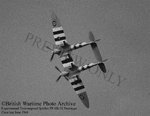Here a hypothetical picture of an eventual planned DE HAVILLAND DH.98 MOSQUITO whit 4 engines.
Hello Grampa,
That looks interesting. If the fuselage would not have been altered extremely, what would have been the advantage in respect to flight aspects? Any data's on this 4 mot Mossy?
Regards
Kruska

